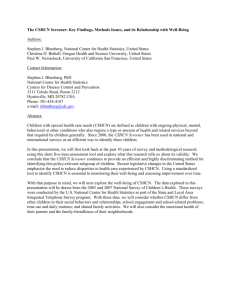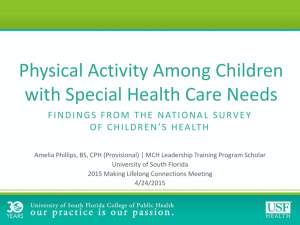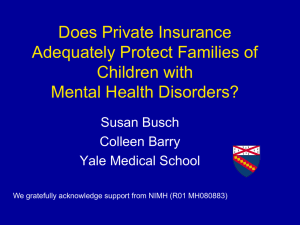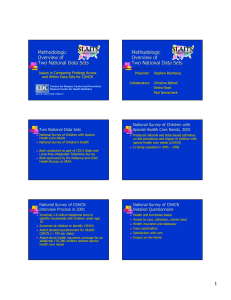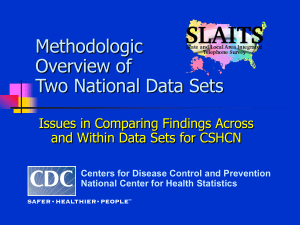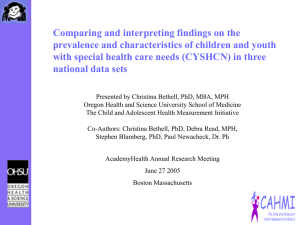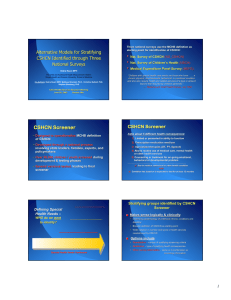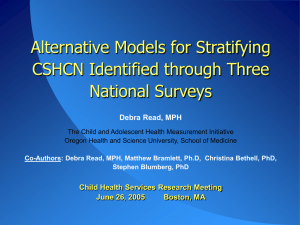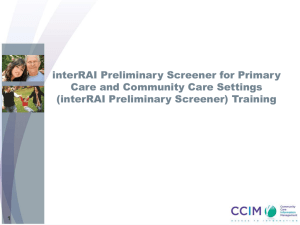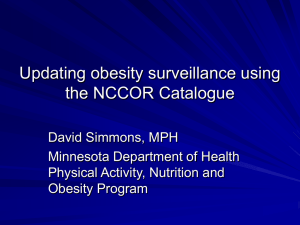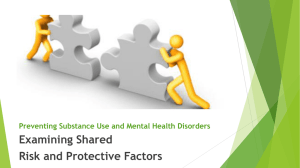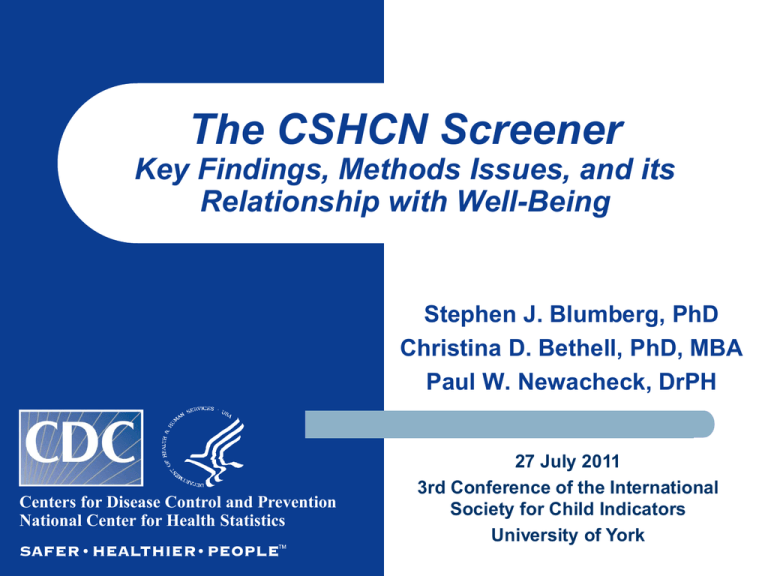
The CSHCN Screener
Key Findings, Methods Issues, and its
Relationship with Well-Being
Stephen J. Blumberg, PhD
Christina D. Bethell, PhD, MBA
Paul W. Newacheck, DrPH
Centers for Disease Control and Prevention
National Center for Health Statistics
27 July 2011
3rd Conference of the International
Society for Child Indicators
University of York
The CSHCN Screener
Key Findings, Methods Issues, and its
Relationship with Well-Being
Children with Special
Health Care Needs
Centers for Disease Control and Prevention
National Center for Health Statistics
27 July 2011
3rd Conference of the International
Society for Child Indicators
University of York
U.S. National Survey of
Children’s Health (NSCH)
Dates: 2003, 2007, 2011
Conducted by: National Center for Health Statistics
Purpose: Produce estimates on the health and wellbeing of children, families, & their communities
Sample: Independent random-digit-dial (RDD) samples
for all 50 states & the District of Columbia (DC)
Random selection: One child 0 – 17 years of age
selected from each household with children to be the
subject of the interview
Goal: Complete interviews for over 91,000 children
nationally (goal: 1,700 completed per state & DC)
Respondent: Parent or guardian
NSCH Sponsor
Has primary responsibility for promoting and improving
the health of U.S. women, children and families.
Provides leadership to improve the physical and mental
health, safety and well-being of the MCH population
Administers block grants to state MCH agencies
Title V MCH Block Grants
The US federal government budgets more than
$1 billion annually for MCH services
In order to be entitled to payments, states must
use at least 30 percent of such payment
amounts for services for children with special
health care needs (CSHCN)
Why CSHCN?
–
CSHCN account for 42% of total medical care costs
(excluding dental costs)
Definition of
“Children with Special Health Care Needs”
“Children with special health care needs are
those who have or are at increased risk for a
chronic physical, developmental, behavioral,
or emotional condition and who also require
health and related services of a type or
amount beyond that required by children
generally.” (McPherson, Arango, Fox, et al., 1998)
Data Source: NSCH, 2007
Home Environment Indicators
CSHCN
Non-CSHCN
4+ family meals together per week
76.0%
77.1%
No tobacco smoke in home
89.9%
93.0%
Watch less than 2 hours of TV per day
45.7%
49.4%
No television in bedroom (age 6-17)
45.6%
51.1%
Parent met all/most friends (6-17)
79.7%
80.9%
Usually/always does all homework (6-17)
77.4%
88.9%
Ever breastfed (age 0-5)
68.3%
76.5%
Told stories or sung to every day (0-5)
65.4%
58.2%
22.7%
30.1%
All of the above
Data Source: NSCH, 2007
Neighborhood and School Indicators
CSHCN
Non-CSHCN
Usually/always engaged in school
69.5%
83.7%
Never repeated a grade
81.5%
91.8%
Participate in after school activities
77.2%
81.7%
Usually/always safe at school
88.8%
89.8%
Usually/always safe in community
84.4%
86.4%
Live in supportive neighborhood
80.4%
83.9%
48.6%
51.8%
Safe and supportive
Data Source: NSCH, 2007
Indicators Related to Social
Behaviors, Activities, and Family
CSHCN
Non-CSHCN
Has problematic social behaviors
17.9%
6.2%
Lacks consistent positive social skills
12.3%
4.6%
No vigorous physical activity
13.2%
9.5%
Does not get adequate sleep daily
41.1%
34.1%
Mother’s health less than very good
52.2%
41.0%
Father’s health less than very good
41.8%
36.3%
Does not share ideas or talk to
parents about things that matter
37.4%
28.1%
Parents usually/always stressed
20.0%
7.9%
Age 6-17:
All ages:
Definition of
“Children with Special Health Care Needs”
“Children with special health care needs are
those who have ... a chronic physical,
developmental, behavioral, or emotional
condition and who also require health and
related services of a type or amount beyond
that required by children generally.”
(McPherson, Arango, Fox, et al., 1998)
Defining
Special Health
Care Needs
NARROWER DEFINITIONS
include only those with
very severe conditions or highly
complex needs
(C only)
BROADER DEFINITIONS
include those with wider array of
conditions, levels of severity
and service use needs
(B + C)
MOST INCLUSIVE DEFINITIONS
include “at risk” groups
(A + B + C)
GROUP A
No special health
care needs
At risk for
developing a
special health
care need
GROUP B
On going health conditions;
above average service use needs;
few to moderate functional
limitations
GROUP C
On going health
conditions; high or complex
service use needs; moderate
to severe functional limitations
Special Health Needs Continuum
What is the CSHCN Screener?
A non-condition-specific, consequences-based method for
identifying CSHCN, targeting Categories B and C
Designed in 1998-2000 by the Child and Adolescent
Health Measurement Initiative (now at OHSU)
Developed through a national process involving
physicians, state leaders, families, methods experts, and
policymakers
Tested with parents of 36,000+ children during
development phase
Several versions tested, leading to final version, which
takes 1 minute for parents to complete
Data for more than 1 million children analyzed since 2000
The CSHCN Screener
Asks about five “common” consequences
1.
2.
3.
4.
5.
Limitation of activities
Need for or use of prescription medication
Need for or use of specialized therapies
Above routine need or use of medical, mental
health, or education services
Need for or receipt of treatment or counseling
for an emotional, behavioral, or developmental
problem
(Bethell, Read, Stein, Blumberg, Wells, & Newacheck, 2002)
The CSHCN Screener
Two follow-up questions
1.
2.
Is this due to a medical, behavioral, or other
health condition?
Is this a condition that has lasted or is expected
to last 12 months or longer?
(Bethell, Read, Stein, Blumberg, Wells, & Newacheck, 2002)
Key Features of CSHCN Screener
Based on parent report
–
Short (1 minute to complete)
–
–
Most amenable to uniform data collection
Costs per item are usually high in government surveys
Longer surveys threaten participation rates
Based on consequences rather than conditions
–
–
–
Condition checklists tend to be very long
Condition checklists are hard to analyze and interpret
Focus on consequences helps capture children with
conditions not yet diagnosed or poorly recalled
“Triangulate” to Validate
SURVEY PARENTS
- Ask about specific health
services children need or use
- Ask about child health status &
impact of any health problems
MEDICAL RECORDS
- Examine encounter &
claims data for diagnoses
listed in children’s records
Group id’d by
CSHCN Screener
COMPARE to:
- CYSHCN identified by other
methods or definitions such as
program eligibility
- Children not identified
SURVEY PARENTS
- Ask to name any specific
diagnoses or health
conditions children have
CLINICAL EVALUATION
- Review of children’s medical charts
by pediatric clinicians
Cross-Method Comparisons
Over 93% of identified CSHCN had at least one
specific chronic health condition or problem,
and most had two or more
Over 98% of identified CSHCN had some type
of functional difficulty, as defined by the
International Classification of Functioning (ICF)
Who is Identified by the Screener?
All or nearly all children with complex health
conditions such as:
–
–
–
–
Cerebral palsy; cystic fibrosis; muscular dystrophy
Rare metabolic or genetic disorders
Mental retardation; developmental delay; autism
Sickle cell anemia; Down Syndrome; diabetes
Only those children whose asthma, ADHD,
allergies, or other conditions result in:
–
–
–
Elevated service use,
Long-term use of prescription medicine, or
Limitations in functioning
Who is Missed by the Screener?
The CSHCN Screener is likely to miss children
who have only:
–
–
–
–
Food or environmental allergies
Special diet (e.g., lactose intolerance)
Vision problems (e.g., amblyopia, colorblindness)
Developmental delays early in life
Some parents of children with speech problems,
learning disabilities, developmental delay, and
conduct problems report consequences but then
say they are not due to “health conditions”
Data Source: NS-CSHCN, 2005-2006
Over-Identification?
Should ongoing need for only prescription
medication be considered a special need?
Should children with only asthma or allergies be
considered CSHCN?
CSHCN with
only Rx needs
CSHCN with
only asthma or
allergies
Non-CSHCN
Mean # of doctor
visits in past year
4.1
4.5
2.3
% with 2+ hospital
emergency visits
13.9
16.2
4.8
Survey-Based Uses of the
CSHCN Screener in the U.S.
National Survey of CSHCN (NS-CSHCN)
National Survey of Children’s Health (NSCH)
Medical Expenditure Panel Survey (MEPS)
Consumer Assessment of Health Plans Survey
(CAHPS)
Data Sources: see legend
19.2%
19.3%
18.8%
MEPS 2001
MEPS 2004
20%
NSCH 2007
Prevalence Differences by Survey
17.6%
NSCH 2003
5%
13.9%
NS-CSHCN 2005-06
10%
12.8%
NS-CSHCN 2001
15%
0%
Prevalence of CSHCN in United States
Why Might Prevalence Rates
Differ Across Surveys?
Dates of data
collection
Method of data
collection and
estimation
–
–
–
–
Mode
Sampling frame
Interviewers
Weighting methods
Sample size and
sampling error
Method of
identification
–
–
–
–
–
Respondent
Recall period
Question wording
Question ordering
Question context
and introduction
Data Sources: see legend
Percent of CSHCN with Each
Consequence Type, by Survey
100%
NS-CSHCN 2001
NSCH 2003
MEPS 2001
NS-CSHCN 2005-2006
NSCH 2007
MEPS 2004
80%
60%
40%
20%
0%
Prescription
Medications
Service Use /
Need
Functional
Limitations
Special
Therapies
Mental Health
Data Source: NS-CSHCN, 2005-2006
Demographic Differences
Prevalence by Sex
Prevalence by Age
18%
16%
14%
12%
10%
8%
6%
4%
2%
0%
16.8%
16.0%
8.8%
0-5 Years
6-11 Years
18%
16%
14%
12%
10%
8%
6%
4%
2%
0%
14.0%
0-99% FPL
14.0%
100-199%
FPL
13.5%
200-399%
FPL
11.6%
Male
12-17 Years
Female
Prevalence by Race/Ethnicity
Prevalence by Income
18%
16%
14%
12%
10%
8%
6%
4%
2%
0%
16.1%
14.0%
400%+ FPL
18%
16%
14%
12%
10%
8%
6%
4%
2%
0%
15.5%
15.0%
8.3%
Non-Hispanic
White
Non-Hispanic
Black
Hispanic
Data Source: NS-CSHCN, 2005-2006
Prevalence by Race/Ethnicity and
Primary Language at Home
Hispanic / Spanish
Hispanic / English
NH White / English
20%
15.6%
15%
13.1%
10%
5%
0%
4.6%
Data Source: NS-CSHCN, 2005-2006
Prevalence by Race/Ethnicity and
Primary Language at Home
Hispanic / Spanish
Hispanic / English
NH White / English
15%
12%
9%
6%
3%
0%
Prescription
Medications
Service Use /
Need
Functional
Limitations
Special
Therapies
Mental Health
Data Source: MEPS, 2004
Prescription Medication Orders Filled,
by Ethnicity and Language of Interview
Hispanic / Spanish
60%
NH White / English
54.5%
45.8%
50%
40%
Hispanic / English
36.8%
30%
20%
5.4%
10%
6.2%
0.8%
0%
Percent of Children
with Any Prescription
Medication Orders
Percent of Children
with Any Psychiatric
Medication Orders
Thanks to Byron A. Foster, Oregon Health and Science University.
The CSHCN Screener
Reliably identifies children requiring on-going
medical and other health-related services
Can be used to stratify children into meaningful
subgroups related to condition complexity
Is sensitive to health care practice patterns (such as
those related to cultural differences)
Yields results that can be influenced by differences
in survey administration
Provides a key health indicator that is related
to the home environment and the well-being
of children and their families

